Fig. 27.1
The half purse-string suture begins at half of the length of the oval and is performed only taking the dermis with a space of 3–4 mm between each suture and ends at the other side of the oval to match the height of input to output, letting it untied until the end of the procedure
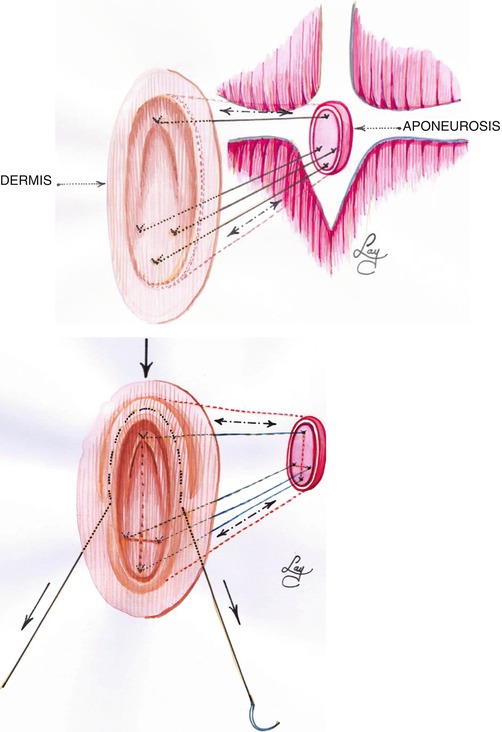
Figs. 27.2 and 27.3
Sutures to get the inverted cross image
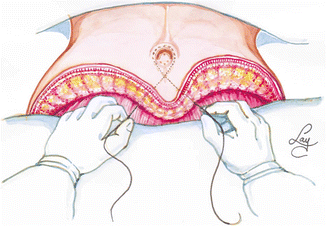
Fig. 27.4
The flap is pulled down and it is temporarily fixed to check the effect of skin roll that the half purse string has by pulling both ends of the suture
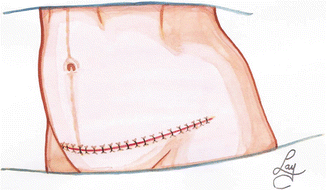
Fig. 27.5
The neoumbilicus is finished and the abdominal wound is closed
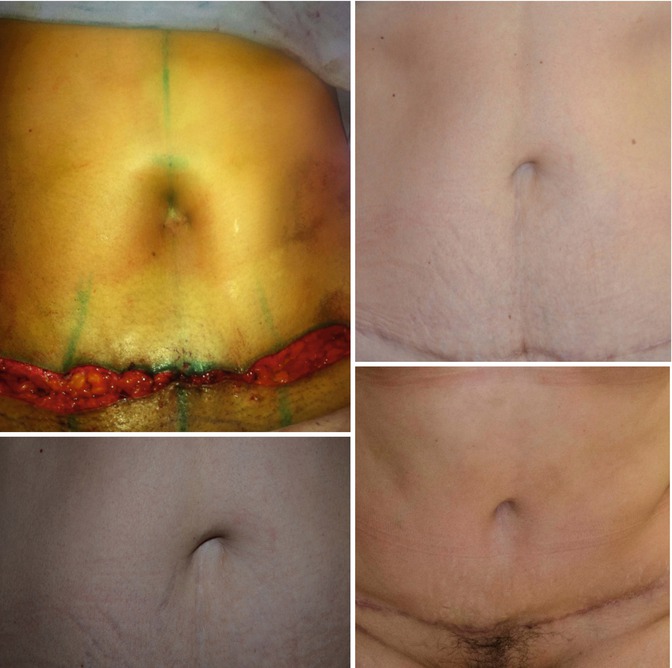
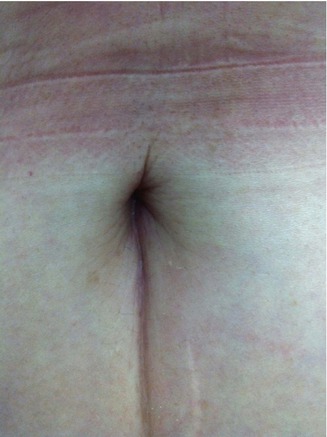
Figs. 27.6, 27.7, 27.8, 27.9, and 27.10
Final results
27.3 Conclusions
There are multiple neoumbilicoplasty techniques that exist to perform during abdominoplasty, dividing these basically in two large groups: those in which the navel is exteriorized and neoumbilicoplasties, being the first one that is most commonly used. Every surgeon has his or her preferred technique, chosen fundamentally on the probability of leaving a less visible external scar. In patients with large diastasis recti and important umbilical hernias, it is necessary occasionally to perform neoumbilicoplasty techniques, due to the possibility of unviability of the umbilical stem, needing to amputate it [1].
The aesthetic result of the navel is one of the biggest stigmas after the abdominoplasty. Despite that beauty is in the eye of the beholder, there exists a consensus that a protruded, horizontal [2, 3], distorted navel with scars that surpass its circumference [4, 5] is not a pleasing result for the patient or the surgeon and is far from being considered an ideal navel.
Numerous neoumbilicuplasty techniques have been described [6–13], some with purse-string suture [14, 15], that have an undebatable use in reconstruction of patients with absence of the navel due to different causes, but produce visible scarring. The technique the authors propose could be used in patients with absence of umbilicus, but it seems excessive to lift the abdominal flap to perform this technique, so in these cases the techniques previously mentioned are recommended.
The new navel should look natural and have a permanent and sufficient deepness [16] in standing position, it must be covered and have a discrete inferior inclination. Gravity plays an important role in the appearance of the navel, but it also results necessary to fixate the abdominal flap to the fascia in the superior tunnel to avoid cephalic traction of the navel. Also, by performing a superior half purse string and fixating 2 cm towards dermis under it allows the confection of the umbilical roof and the inverted cone shape.
Pallua et al. [2] made an exhaustive clinical analysis about shape and location of the aesthetically acceptable navel. They concluded that the ideal umbilical shape in both genders is oval positioned in the middle third of the distance between xiphoid appendix and pubis. There exist many reports that analyze the umbilical shape, some define the aesthetically acceptable belly button in a vertical shape [17, 18], while Craig et al. [3] affirm, based on photographic studies, that the most acceptable umbilical silhouette is a small one with a “T” or vertical disposition and a superior skinfold; finding as unaesthetic features a large, horizontal, or distorted navel with protruded skin excess.
Pitanguy favored a horizontal shape [19], while Delerm [20] as Schoeller et al. [21] preferred a rounded or elliptical shape. The latter author describes a purse-string suture technique in a defatted area over the abdominal flap that sutures a previously deepithelialized umbilical stem, obtaining in this manner a new umbilicus with no external scars.
Stay updated, free articles. Join our Telegram channel

Full access? Get Clinical Tree







